a9c55f047665134abb0444949c6b1893.ppt
- Количество слайдов: 105
 SYSTEMS ENGINEERING COURSE Hervé Panetto, Professor University of Lorraine, TELECOM Nancy Research Centre for Automatic Control (CRAN UMR 7039 CNRS) Chair of IFAC CC 5 « Manufacturing and Logistics Systems » Herve. Panetto@univ-Lorraine. fr Based on slides from Alain Faisandier (MAP Systems)
SYSTEMS ENGINEERING COURSE Hervé Panetto, Professor University of Lorraine, TELECOM Nancy Research Centre for Automatic Control (CRAN UMR 7039 CNRS) Chair of IFAC CC 5 « Manufacturing and Logistics Systems » Herve. Panetto@univ-Lorraine. fr Based on slides from Alain Faisandier (MAP Systems)
 Copyright This work is licensed under Creative Commons Attribution. Non. Commercial-Share. Alike 3. 0 available online at http: //creativecommons. org/licenses/by-nc-sa/3. 0/
Copyright This work is licensed under Creative Commons Attribution. Non. Commercial-Share. Alike 3. 0 available online at http: //creativecommons. org/licenses/by-nc-sa/3. 0/
 Complex System Examples Information Systems
Complex System Examples Information Systems
 System Problems Examples
System Problems Examples
 System Problems Examples
System Problems Examples
 SYSTEMS ENGINEERING 1 – CONCEPT OF SYSTEM 2 – BASIC MODELING TECHNIQUES 3 – CONCEPT OF SYSTEMS ENGINEERING
SYSTEMS ENGINEERING 1 – CONCEPT OF SYSTEM 2 – BASIC MODELING TECHNIQUES 3 – CONCEPT OF SYSTEMS ENGINEERING
 INTRODUCTION 1 – CONCEPT OF SYSTEM 2 – BASIC MODELING TECHNIQUES 3 – CONCEPT OF SYSTEMS ENGINEERING 1
INTRODUCTION 1 – CONCEPT OF SYSTEM 2 – BASIC MODELING TECHNIQUES 3 – CONCEPT OF SYSTEMS ENGINEERING 1
 1 "What means the term "system"? What is a system ? " Could you give any elements of a definition ?
1 "What means the term "system"? What is a system ? " Could you give any elements of a definition ?
 Definitions from the current international standards 1 ISO/IEC 15288 definition A system is a combination of interacting elements organized to achieve one or more stated purposes. ¦ NOTE 1: A system may be considered as a product or as the services it provides. ¦ NOTE 2: In practice, the interpretation of its meaning is frequently clarified by the use of an associative noun, e. g. aircraft system. ANSI/EIA 632 definition A system is an aggregation of end products and enabling products to achieve a given purpose. ¦ A system consists of both the end products to be used by an acquirer for an intended purpose and the set of enabling products that enable the creation, realization, and use of an end product, or an aggregation of end products. This definition is confusing and does not allow to simplify the engineering of complex systems !
Definitions from the current international standards 1 ISO/IEC 15288 definition A system is a combination of interacting elements organized to achieve one or more stated purposes. ¦ NOTE 1: A system may be considered as a product or as the services it provides. ¦ NOTE 2: In practice, the interpretation of its meaning is frequently clarified by the use of an associative noun, e. g. aircraft system. ANSI/EIA 632 definition A system is an aggregation of end products and enabling products to achieve a given purpose. ¦ A system consists of both the end products to be used by an acquirer for an intended purpose and the set of enabling products that enable the creation, realization, and use of an end product, or an aggregation of end products. This definition is confusing and does not allow to simplify the engineering of complex systems !
 century XVIII … an abstract concept From Encyclopedia of D. DIDEROT version 2 : 1 SYSTEM (metaphysical) is nothing else than the provision of the various parts of an art or a science in a state where they support themselves all mutually, and where the last ones are explained by the first ones. Those which return reason of the others are called principles ; and the system is more perfect if the principles are in smaller number : it is to even wish to reduce them to only one. Because just as in a clock, there is a principal spring on which all the others depend, in all the systems there is also a first principle to which the various parts are subordinate to the others which make it up. " "SYSTEM (philosophy) generally means assembly or sequence of principles and conclusions ; or everything and the whole of a theory of which the various parts are dependent between them, follow and depend the ones on the others. This word is made of a Greek word which means composition or assembly. In this meaning, it is known as : a philosophy system, an astronomy system, the Descartes’s system , Newton’s one … "SYSTEM (astronomy) is the assumption of a certain arrangement of the various parts which make the universe, according to this assumption the astronomers explain all the phenomena or appearances of the celestial bodies. "
century XVIII … an abstract concept From Encyclopedia of D. DIDEROT version 2 : 1 SYSTEM (metaphysical) is nothing else than the provision of the various parts of an art or a science in a state where they support themselves all mutually, and where the last ones are explained by the first ones. Those which return reason of the others are called principles ; and the system is more perfect if the principles are in smaller number : it is to even wish to reduce them to only one. Because just as in a clock, there is a principal spring on which all the others depend, in all the systems there is also a first principle to which the various parts are subordinate to the others which make it up. " "SYSTEM (philosophy) generally means assembly or sequence of principles and conclusions ; or everything and the whole of a theory of which the various parts are dependent between them, follow and depend the ones on the others. This word is made of a Greek word which means composition or assembly. In this meaning, it is known as : a philosophy system, an astronomy system, the Descartes’s system , Newton’s one … "SYSTEM (astronomy) is the assumption of a certain arrangement of the various parts which make the universe, according to this assumption the astronomers explain all the phenomena or appearances of the celestial bodies. "
 1 … Modern translation A "System" is primarily an abstract concept which includes a purpose (final goal) It is defined by an intended use (a mission) and a boundary No purpose No mission No boundary System systems engineering What are the limits to consider something as a system ? • Is an elementary component a system? • Is the human society a system?
1 … Modern translation A "System" is primarily an abstract concept which includes a purpose (final goal) It is defined by an intended use (a mission) and a boundary No purpose No mission No boundary System systems engineering What are the limits to consider something as a system ? • Is an elementary component a system? • Is the human society a system?
 1 Foundation The term “system" was used in the past in philosophy and metaphysics ; It was the source of the “systemic“ approach. Nowadays, systemic focuses on : ¦ The General Theory of Systems (generic model of the world and its phenomena) ¦ Methods to model abstract complex products System Engineering is twofold and addresses : ¦ System vision of products / services ¦ Basic Models and Generic Processes for modelling A system = A set of dynamic interactions under operational conditions relation ? ? relation ? Models within the Engineering Processes Define the System Define stakeholders needs Design the System Define Technical Requirements Design Logical Architecture Describe the context of the system: relation ? Physical limits Functional limits Exchanged flows Execution frequency Design Physical Architecture Describe system inside: Components Basic models: Semantic Functional Dynamic Temporal Functions Exchanged flows Execution frequency
1 Foundation The term “system" was used in the past in philosophy and metaphysics ; It was the source of the “systemic“ approach. Nowadays, systemic focuses on : ¦ The General Theory of Systems (generic model of the world and its phenomena) ¦ Methods to model abstract complex products System Engineering is twofold and addresses : ¦ System vision of products / services ¦ Basic Models and Generic Processes for modelling A system = A set of dynamic interactions under operational conditions relation ? ? relation ? Models within the Engineering Processes Define the System Define stakeholders needs Design the System Define Technical Requirements Design Logical Architecture Describe the context of the system: relation ? Physical limits Functional limits Exchanged flows Execution frequency Design Physical Architecture Describe system inside: Components Basic models: Semantic Functional Dynamic Temporal Functions Exchanged flows Execution frequency
 A complete statement (text view ) 1 “A system is a collection of components such as people, hardware, software, materials, procedures or services ¦ that are gathered, and synchronized Ä so that the mutual interactions, using resources in a given environment Ø satisfies the needs and expectations – that are derived from the mission and the objectives * themselves derived from its purpose”. This is a more useful definition of "system" than the ones in the standards
A complete statement (text view ) 1 “A system is a collection of components such as people, hardware, software, materials, procedures or services ¦ that are gathered, and synchronized Ä so that the mutual interactions, using resources in a given environment Ø satisfies the needs and expectations – that are derived from the mission and the objectives * themselves derived from its purpose”. This is a more useful definition of "system" than the ones in the standards
 1 A complete statement (E/R view) Purpose traces to Mission Objectives traces to Needs & expectations satisfied by Mutual interactions of functions performed by Components
1 A complete statement (E/R view) Purpose traces to Mission Objectives traces to Needs & expectations satisfied by Mutual interactions of functions performed by Components
 Engineering needs a recursive definition of the term "System" Needs & requirements view 1 System is characterized by Needs Purpose Mission Requirements = Expected features Objectives described & declined through interact with Operational Scenarios Architectures view Interface view Extern System set up Functions Extern System perform Components = The definition is applied at lower levels of breakdown (sub) Systems
Engineering needs a recursive definition of the term "System" Needs & requirements view 1 System is characterized by Needs Purpose Mission Requirements = Expected features Objectives described & declined through interact with Operational Scenarios Architectures view Interface view Extern System set up Functions Extern System perform Components = The definition is applied at lower levels of breakdown (sub) Systems
 "System" definition: summarize 1 Three major views "Needs and Requirements" View ¦ Purpose (Final Goal) = Why the system does exist ? ¦ Mission = What it does (transforms) ? ¦ Objectives = How many inputs it transform? What is the thoughput … ? "Functional/logical Architecture" View ¦ A structure of functions that allows the system to perform all the identified operational scenarios throughout its life-cycle ¦ Includes exchanged flows between functions and external world (interface) "Physical Architecture" View ¦ A set of concrete components that support both functions and interactions between the components ¦ Includes physical connexions With a "hierarchical " aspect ¦ System models are refined into system layers, each system being characterize by its purpose, its mission, … The definition is recursive
"System" definition: summarize 1 Three major views "Needs and Requirements" View ¦ Purpose (Final Goal) = Why the system does exist ? ¦ Mission = What it does (transforms) ? ¦ Objectives = How many inputs it transform? What is the thoughput … ? "Functional/logical Architecture" View ¦ A structure of functions that allows the system to perform all the identified operational scenarios throughout its life-cycle ¦ Includes exchanged flows between functions and external world (interface) "Physical Architecture" View ¦ A set of concrete components that support both functions and interactions between the components ¦ Includes physical connexions With a "hierarchical " aspect ¦ System models are refined into system layers, each system being characterize by its purpose, its mission, … The definition is recursive
 1 Practice with the help of examples, indicate the differences between : purpose, mission, objectives system A car manufacturer One production line purpose mission objectives ? identify, design, produce, sell cars 2 new models per year produce cars ? assemble parts why ? what ? make money, provide jobs, provide means for transportation ? ? ? 10 5 cars per year ? 25 000 cars how much ?
1 Practice with the help of examples, indicate the differences between : purpose, mission, objectives system A car manufacturer One production line purpose mission objectives ? identify, design, produce, sell cars 2 new models per year produce cars ? assemble parts why ? what ? make money, provide jobs, provide means for transportation ? ? ? 10 5 cars per year ? 25 000 cars how much ?
 Purpose, mission and objectives ? 1 Purpose : provide people transportation for various destinations Mission : transport people, goods or both, from one point to another Objectives : 1 to 6 persons at the same time – distances of 30 km max. transportation system with driver
Purpose, mission and objectives ? 1 Purpose : provide people transportation for various destinations Mission : transport people, goods or both, from one point to another Objectives : 1 to 6 persons at the same time – distances of 30 km max. transportation system with driver
 1 Scenarios ? Go to the requested point Board client Perform the ride Answer a call one scenario among others. . . Refuel Disembark client Cash
1 Scenarios ? Go to the requested point Board client Perform the ride Answer a call one scenario among others. . . Refuel Disembark client Cash
 Functions ? Functions : answer calls - go to requested point - board passengers - perform the ride - refuel, - maintain the vehicle in operational conditions, - change the vehicle – feed the driver. . . transportation system with driver Functions 1
Functions ? Functions : answer calls - go to requested point - board passengers - perform the ride - refuel, - maintain the vehicle in operational conditions, - change the vehicle – feed the driver. . . transportation system with driver Functions 1
 Interfaces with the environment (context of use) ? Interfaces with : 1 passengers, refuelling system - vehicle repairing system - health care system for the driver - road signs - calls switching system… transportation system with driver Functions
Interfaces with the environment (context of use) ? Interfaces with : 1 passengers, refuelling system - vehicle repairing system - health care system for the driver - road signs - calls switching system… transportation system with driver Functions
 1 Components ? Components : vehicle – navigation device – communication device – driver. . . Functions
1 Components ? Components : vehicle – navigation device – communication device – driver. . . Functions
 1 Constraints and resources ? Resources (necessary inputs) fuel – change (coins) food. . . Constraints weight - size volume - space speed, standards, … Functions
1 Constraints and resources ? Resources (necessary inputs) fuel – change (coins) food. . . Constraints weight - size volume - space speed, standards, … Functions
 Hierarchical aspect : in fact encapsulation & boundary 1 External system em External system st er sy pp - U er Upp External system sy Upper System of interest External system Hierarchy of nested systems "Russian dolls"
Hierarchical aspect : in fact encapsulation & boundary 1 External system em External system st er sy pp - U er Upp External system sy Upper System of interest External system Hierarchy of nested systems "Russian dolls"
 Exercise / example : An enterprise as a system (1) 1 The Needs & Requirements" view ¦ Purposes = enrich a nation or sets of people, or allows the exchange of goods, energy and services between humans, etc. ¦ Missions = production of goods or energy, or provision of services, or transportation of goods and humans, or maintenance of products, or disposal of infrastructures, etc. ¦ Objectives = all quantitative and qualitative aspects that are associated to missions: how many goods to produce per day, or how many people to transport per month, or how many students to teach per year, etc.
Exercise / example : An enterprise as a system (1) 1 The Needs & Requirements" view ¦ Purposes = enrich a nation or sets of people, or allows the exchange of goods, energy and services between humans, etc. ¦ Missions = production of goods or energy, or provision of services, or transportation of goods and humans, or maintenance of products, or disposal of infrastructures, etc. ¦ Objectives = all quantitative and qualitative aspects that are associated to missions: how many goods to produce per day, or how many people to transport per month, or how many students to teach per year, etc.
 Exercise / example : An enterprise as a system (2) 1 The logical / functional architecture view ¦ high level functions such as "develop new products"; products; sell products; manage the internal means and make the link with external social administrations and laws, etc. Ä these functions are decomposed into processes, the processes into activities, the activities in tasks, etc. Ä a process or an activity is no more than a function ¦ Functional interfaces & limits = the enterprise defines its activities around its core business, subcontracts enabling services to acquire necessary resources and/or subcontracts part of its activities The physical architecture view ¦ organizational entities of Personnel, Experts, Managers, Executives structured in Services, Departments, Divisions, Corporate, etc. ¦ Physical boundary = Partners, customers, suppliers, competitors, geographic levels of intervention (local, national, international), administrations
Exercise / example : An enterprise as a system (2) 1 The logical / functional architecture view ¦ high level functions such as "develop new products"; products; sell products; manage the internal means and make the link with external social administrations and laws, etc. Ä these functions are decomposed into processes, the processes into activities, the activities in tasks, etc. Ä a process or an activity is no more than a function ¦ Functional interfaces & limits = the enterprise defines its activities around its core business, subcontracts enabling services to acquire necessary resources and/or subcontracts part of its activities The physical architecture view ¦ organizational entities of Personnel, Experts, Managers, Executives structured in Services, Departments, Divisions, Corporate, etc. ¦ Physical boundary = Partners, customers, suppliers, competitors, geographic levels of intervention (local, national, international), administrations
 Exercise / example : An enterprise as a system ( 3) 1 The "hierarchical" aspect ¦ Each physical entity of the enterprise (Corporate, Divisions, Departments, Services) can be seen in its turn as a system. Ä At lower levels of decomposition, an entity is physically composed of "human roles", written procedures, tools and other means. ¦ Developing a new product is generally achieved via a "project team" that can be viewed also as a system.
Exercise / example : An enterprise as a system ( 3) 1 The "hierarchical" aspect ¦ Each physical entity of the enterprise (Corporate, Divisions, Departments, Services) can be seen in its turn as a system. Ä At lower levels of decomposition, an entity is physically composed of "human roles", written procedures, tools and other means. ¦ Developing a new product is generally achieved via a "project team" that can be viewed also as a system.
 1 Generalized vision of systems DEFENSE SYSTEM ARMY FORCE SYSTEM AIR FORCE SYSTEM LOGISTICS SUPPORT SYSTEM GLOBAL COMMAND SYSTEM . . . TROOPS TRANSPORTATION VEHICLE SYSTEM NAVY FORCE SYSTEM. . . Local Command system Mobility system Survivability system Boundaries of the system . . .
1 Generalized vision of systems DEFENSE SYSTEM ARMY FORCE SYSTEM AIR FORCE SYSTEM LOGISTICS SUPPORT SYSTEM GLOBAL COMMAND SYSTEM . . . TROOPS TRANSPORTATION VEHICLE SYSTEM NAVY FORCE SYSTEM. . . Local Command system Mobility system Survivability system Boundaries of the system . . .
 A system always needs "enabling" services 1 The interest TROOPS TRANSPORTATION VEHICLE SYSTEM must be designed developed recycled must be built/ produced sustained sold must be
A system always needs "enabling" services 1 The interest TROOPS TRANSPORTATION VEHICLE SYSTEM must be designed developed recycled must be built/ produced sustained sold must be
 The enabling services are also implemented by systems 1 The interest TROOPS TRANSPORTATION VEHICLE SYSTEM requires a Design system Retirement system requires a Manufacturing system Support system Commercial system requires a
The enabling services are also implemented by systems 1 The interest TROOPS TRANSPORTATION VEHICLE SYSTEM requires a Design system Retirement system requires a Manufacturing system Support system Commercial system requires a
 1 Example Deployment system Design system Support system requires Retirement system Weapon system is built from Operations system Design system Production system requires Support system Retirement system
1 Example Deployment system Design system Support system requires Retirement system Weapon system is built from Operations system Design system Production system requires Support system Retirement system
 System Definition Mission System Users Sub System Border Sub System Stakeholders Environment
System Definition Mission System Users Sub System Border Sub System Stakeholders Environment
 System Meta Model From INCOSE
System Meta Model From INCOSE
 INTRODUCTION 1 – CONCEPT OF SYSTEM 2 – BASIC MODELING TECHNIQUES 3 – CONCEPT OF SYSTEMS ENGINEERING 2
INTRODUCTION 1 – CONCEPT OF SYSTEM 2 – BASIC MODELING TECHNIQUES 3 – CONCEPT OF SYSTEMS ENGINEERING 2
 2 What means modeling in general ? Model An object A is a model of an object B if an observer can use A to answer questions that interest him about B. Abstraction of the reality which represents some aspects of the actual process considered as important by the "modeler". Minsky, 1985 Marquardt, 1994 Modeling Intended action to work out and build models (using sets of symbols). These models might be capable to make understandable a system perceived as complex. They allow reasoning in order to anticipate consequences of potential system's actions. from J. L Le. Moigne
2 What means modeling in general ? Model An object A is a model of an object B if an observer can use A to answer questions that interest him about B. Abstraction of the reality which represents some aspects of the actual process considered as important by the "modeler". Minsky, 1985 Marquardt, 1994 Modeling Intended action to work out and build models (using sets of symbols). These models might be capable to make understandable a system perceived as complex. They allow reasoning in order to anticipate consequences of potential system's actions. from J. L Le. Moigne
 2 Modeling and & Simulation Actual system EXPERIMENTS (REAL TESTS) SIMULATION (VIRTUAL TESTS) MODELING Process which establishes a formalized structure used to explain a set of phenomena which have relationships between them. Simulated system Mathematical model Process which conducts experiments using the model in order, either to understand the behavior of the system, or assess various operating strategies of the system.
2 Modeling and & Simulation Actual system EXPERIMENTS (REAL TESTS) SIMULATION (VIRTUAL TESTS) MODELING Process which establishes a formalized structure used to explain a set of phenomena which have relationships between them. Simulated system Mathematical model Process which conducts experiments using the model in order, either to understand the behavior of the system, or assess various operating strategies of the system.
 What means modeling for systems ? 2 For analyzing complex systems, we use modeling techniques with formal and graphical representations. ¦ A model is a representation of reality (physical phenomenon, process…) with symbols organized according to conventions ¦ A "logical" model is independent from any implementation ¦ A model is a restricting abstraction of a real system (e. g. : a map, a mock-up, mathematical laws. . . ) Restricting the reality is not a model defect; this allows : Ä to remove useless details for comprehension Ä to focus on main points
What means modeling for systems ? 2 For analyzing complex systems, we use modeling techniques with formal and graphical representations. ¦ A model is a representation of reality (physical phenomenon, process…) with symbols organized according to conventions ¦ A "logical" model is independent from any implementation ¦ A model is a restricting abstraction of a real system (e. g. : a map, a mock-up, mathematical laws. . . ) Restricting the reality is not a model defect; this allows : Ä to remove useless details for comprehension Ä to focus on main points
 2 System Modeling (1) Engineering a system is an abstract work that requires to model and to reason on several but consistent point of views System Physical Functional Dynamic Physical Architecture Semantic Scenarios Functional & Dynamical architecture Temporal Modes transition Processes Basic activities Data Model & related flows Projection / allocations
2 System Modeling (1) Engineering a system is an abstract work that requires to model and to reason on several but consistent point of views System Physical Functional Dynamic Physical Architecture Semantic Scenarios Functional & Dynamical architecture Temporal Modes transition Processes Basic activities Data Model & related flows Projection / allocations
 System Modeling (2) 2 Several models of the same system are necessary for its understanding. Different model kind: ¦ Semantic model (static aspect, data structure, …) ¦ Functional model (transformation, processing of inputs) ¦ Dynamic model (functions control and linking, state/transition, events) ¦ Temporal model (function execution and decision making within time) ¦ Physical model (components and physical connexions) ¦ Complementary models : Ä Performances (mock-up) Ä Human-System interfaces Ä Dependability. . . We model at least on two levels to understand a system : ¦ To describe the "Needs" within its context (The system as a black box in its operational environment) ¦ The candidate solutions (How the system is built inside)
System Modeling (2) 2 Several models of the same system are necessary for its understanding. Different model kind: ¦ Semantic model (static aspect, data structure, …) ¦ Functional model (transformation, processing of inputs) ¦ Dynamic model (functions control and linking, state/transition, events) ¦ Temporal model (function execution and decision making within time) ¦ Physical model (components and physical connexions) ¦ Complementary models : Ä Performances (mock-up) Ä Human-System interfaces Ä Dependability. . . We model at least on two levels to understand a system : ¦ To describe the "Needs" within its context (The system as a black box in its operational environment) ¦ The candidate solutions (How the system is built inside)
 Design the right system How the customer explained it How the project leader understood it How the analyst designed it How the business consultant described it How the programmer wrote it What the beta testers received How the project was documented
Design the right system How the customer explained it How the project leader understood it How the analyst designed it How the business consultant described it How the programmer wrote it What the beta testers received How the project was documented
 Process Definition Set of interrelated of interacting activities which transforms inputs to outputs Inputs Outputs P
Process Definition Set of interrelated of interacting activities which transforms inputs to outputs Inputs Outputs P
 A Process
A Process
 Process: V cycle
Process: V cycle
 Iterative and Incremental Iterative Incremental
Iterative and Incremental Iterative Incremental
 Barry W. Boehm
Barry W. Boehm
 Iterative and Incremental The Systems Engineering Process is not sequential. It is parallel and iterative. The complex interrelationship between creating and improving models throughout the process of developing and selecting alternatives is a good example of the dynamic nature of the systems engineering process.
Iterative and Incremental The Systems Engineering Process is not sequential. It is parallel and iterative. The complex interrelationship between creating and improving models throughout the process of developing and selecting alternatives is a good example of the dynamic nature of the systems engineering process.
 Process Standardization NASA DOD (US Departement Of Defense): ¦Documentation Model IEEE ISO (International Organization for Standardization) IEC (International Electrotechnical Committee). ¦ISO/IEC 15504 / SPICE (Software Process Improvement and Capability d. Etermination) SEI (Software Engineering Institute)
Process Standardization NASA DOD (US Departement Of Defense): ¦Documentation Model IEEE ISO (International Organization for Standardization) IEC (International Electrotechnical Committee). ¦ISO/IEC 15504 / SPICE (Software Process Improvement and Capability d. Etermination) SEI (Software Engineering Institute)
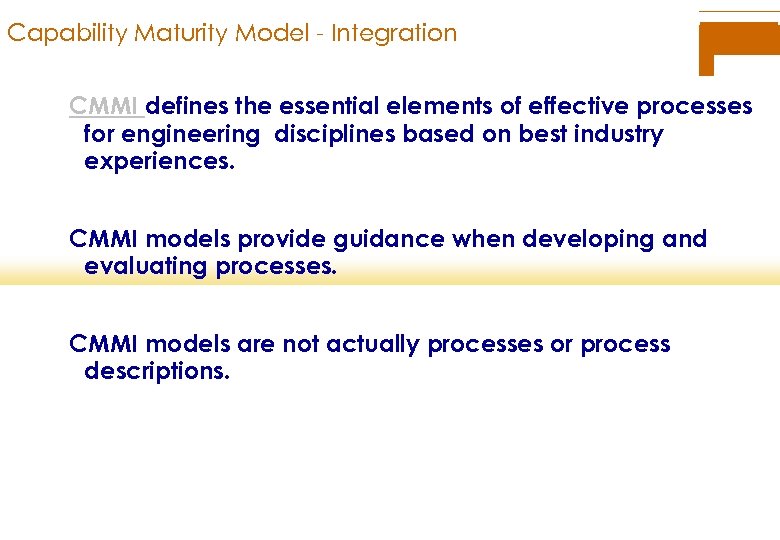 Capability Maturity Model - Integration CMMI defines the essential elements of effective processes for engineering disciplines based on best industry experiences. CMMI models provide guidance when developing and evaluating processes. CMMI models are not actually processes or process descriptions.
Capability Maturity Model - Integration CMMI defines the essential elements of effective processes for engineering disciplines based on best industry experiences. CMMI models provide guidance when developing and evaluating processes. CMMI models are not actually processes or process descriptions.
 CMMI Maturity Levels Level Identified as Status 5 optimizing focus on process improvement 4 quantitatively managed process measured and controlled defined process characterized for the organization and is proactive managed process characterized by projects and often reactive initial process uncontrolled poorly managed and reactive 3 2 1
CMMI Maturity Levels Level Identified as Status 5 optimizing focus on process improvement 4 quantitatively managed process measured and controlled defined process characterized for the organization and is proactive managed process characterized by projects and often reactive initial process uncontrolled poorly managed and reactive 3 2 1
 INTRODUCTION 1 – CONCEPT OF SYSTEM 2 – BASIC MODELING TECHNIQUES 3 – CONCEPT OF SYSTEMS ENGINEERING 3
INTRODUCTION 1 – CONCEPT OF SYSTEM 2 – BASIC MODELING TECHNIQUES 3 – CONCEPT OF SYSTEMS ENGINEERING 3
 Information under which the system is known and should be understood time Concrete product po s al n % of information on physical elements Dis ra eg era tio n n % of information on abstract elements mock-up / architectural concept Digital mock-up CAD System Engineering Source MAP système Op (CDR) Int (PDR) tio Preliminary Critical System Design Re al iza Technical Needs and Requirements expectations (SRR) tio 3 Form the idea … up to the completion
Information under which the system is known and should be understood time Concrete product po s al n % of information on physical elements Dis ra eg era tio n n % of information on abstract elements mock-up / architectural concept Digital mock-up CAD System Engineering Source MAP système Op (CDR) Int (PDR) tio Preliminary Critical System Design Re al iza Technical Needs and Requirements expectations (SRR) tio 3 Form the idea … up to the completion
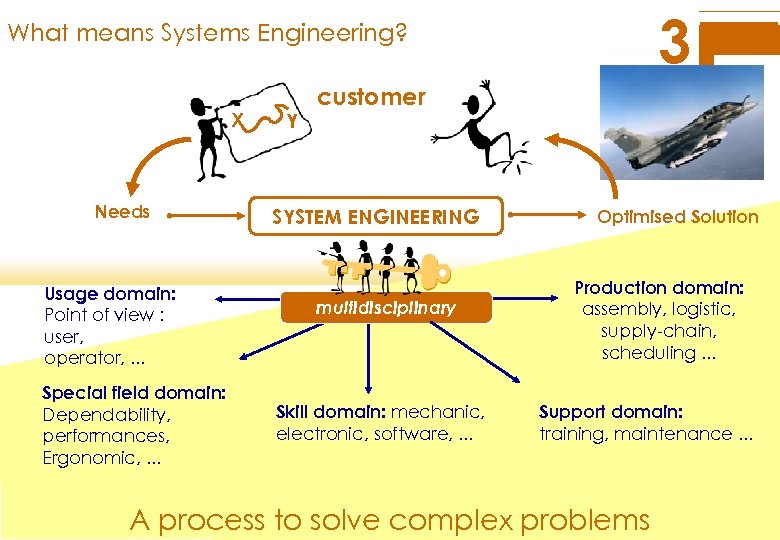 3 What means Systems Engineering? X Needs Usage domain: Point of view : user, operator, . . . Special field domain: Dependability, performances, Ergonomic, . . . Y customer SYSTEM ENGINEERING multidisciplinary Skill domain: mechanic, electronic, software, . . . Optimised Solution Production domain: assembly, logistic, supply-chain, scheduling. . . Support domain: training, maintenance. . . A process to solve complex problems
3 What means Systems Engineering? X Needs Usage domain: Point of view : user, operator, . . . Special field domain: Dependability, performances, Ergonomic, . . . Y customer SYSTEM ENGINEERING multidisciplinary Skill domain: mechanic, electronic, software, . . . Optimised Solution Production domain: assembly, logistic, supply-chain, scheduling. . . Support domain: training, maintenance. . . A process to solve complex problems
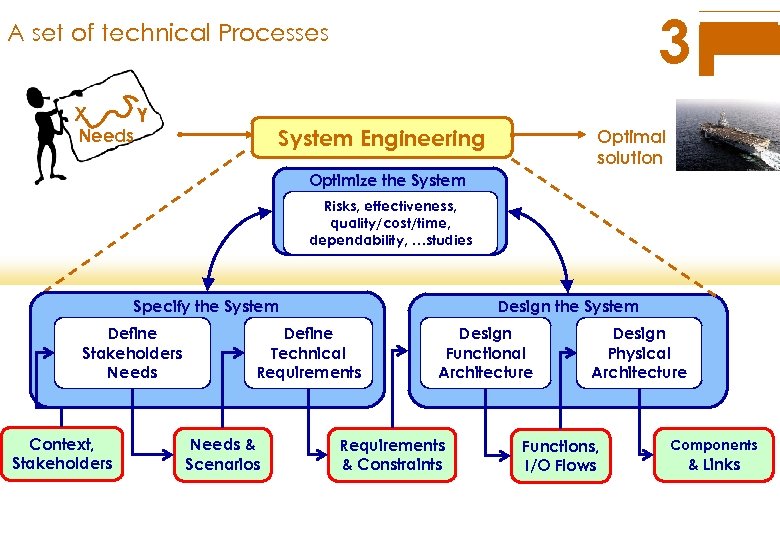 3 A set of technical Processes X Needs Y System Engineering Optimal solution Optimize the System Risks, effectiveness, quality/cost/time, dependability, …studies Specify the System Define Stakeholders Needs Context, Stakeholders Design the System Define Technical Requirements Needs & Scenarios Design Functional Architecture Requirements & Constraints Design Physical Architecture Functions, I/O Flows Components & Links
3 A set of technical Processes X Needs Y System Engineering Optimal solution Optimize the System Risks, effectiveness, quality/cost/time, dependability, …studies Specify the System Define Stakeholders Needs Context, Stakeholders Design the System Define Technical Requirements Needs & Scenarios Design Functional Architecture Requirements & Constraints Design Physical Architecture Functions, I/O Flows Components & Links
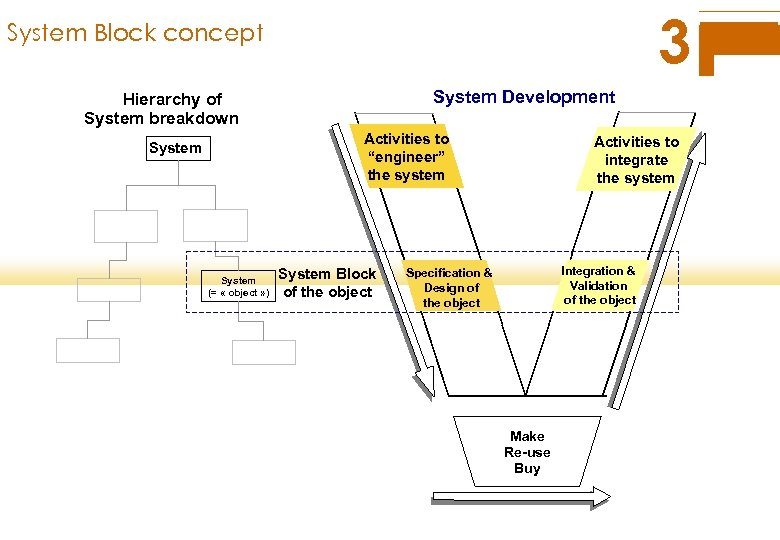 3 System Block concept Hierarchy of System breakdown System Development Activities to “engineer” the system System (= « object » ) System Block of the object Activities to integrate the system Specification & Design of the object Integration & Validation of the object Make Re-use Buy
3 System Block concept Hierarchy of System breakdown System Development Activities to “engineer” the system System (= « object » ) System Block of the object Activities to integrate the system Specification & Design of the object Integration & Validation of the object Make Re-use Buy
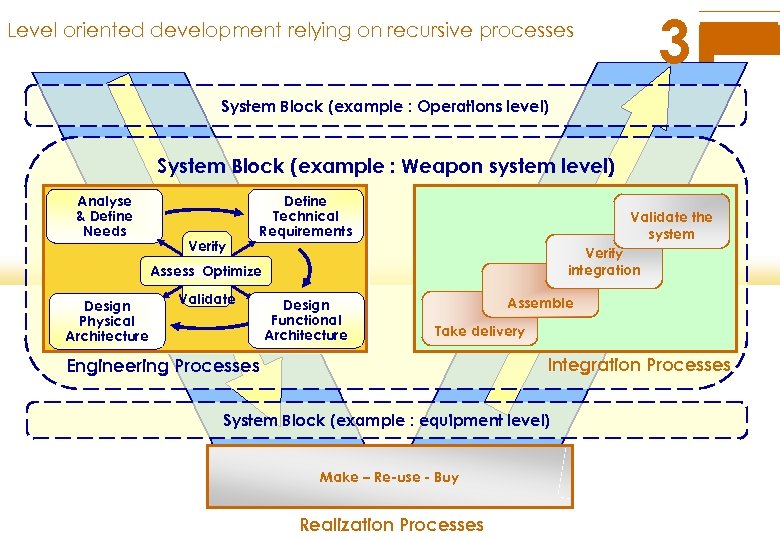 3 Level oriented development relying on recursive processes System Block (example : Operations level) System Block (example : Weapon system level) Analyse & Define Needs Verify Define Technical Requirements Validate the system Verify integration Assess Optimize Design Physical Architecture Validate Design Functional Architecture Assemble Take delivery Integration Processes Engineering Processes System Block (example : equipment level) Make – Re-use - Buy Realization Processes
3 Level oriented development relying on recursive processes System Block (example : Operations level) System Block (example : Weapon system level) Analyse & Define Needs Verify Define Technical Requirements Validate the system Verify integration Assess Optimize Design Physical Architecture Validate Design Functional Architecture Assemble Take delivery Integration Processes Engineering Processes System Block (example : equipment level) Make – Re-use - Buy Realization Processes
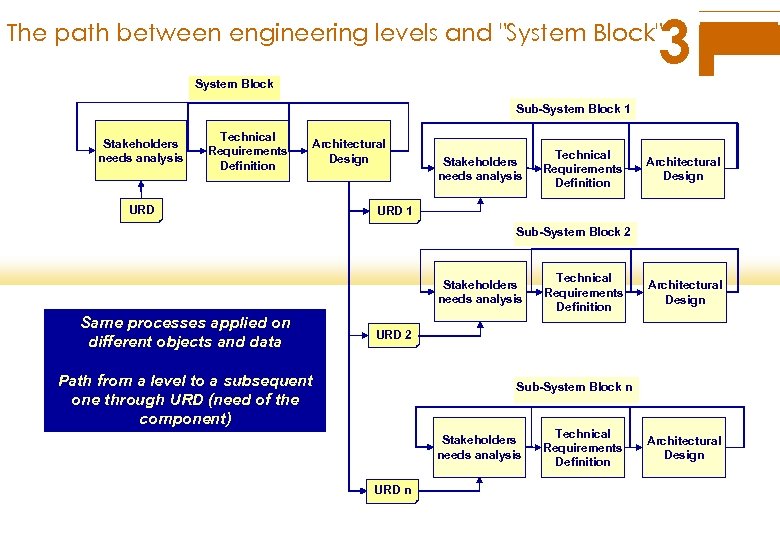 3 The path between engineering levels and "System Block" System Block Sub-System Block 1 Stakeholders needs analysis Technical Requirements Definition Architectural Design URD 1 Sub-System Block 2 Stakeholders needs analysis Same processes applied on different objects and data Technical Requirements Definition Architectural Design URD 2 Path from a level to a subsequent one through URD (need of the component) Sub-System Block n Stakeholders needs analysis URD n Technical Requirements Definition Architectural Design
3 The path between engineering levels and "System Block" System Block Sub-System Block 1 Stakeholders needs analysis Technical Requirements Definition Architectural Design URD 1 Sub-System Block 2 Stakeholders needs analysis Same processes applied on different objects and data Technical Requirements Definition Architectural Design URD 2 Path from a level to a subsequent one through URD (need of the component) Sub-System Block n Stakeholders needs analysis URD n Technical Requirements Definition Architectural Design
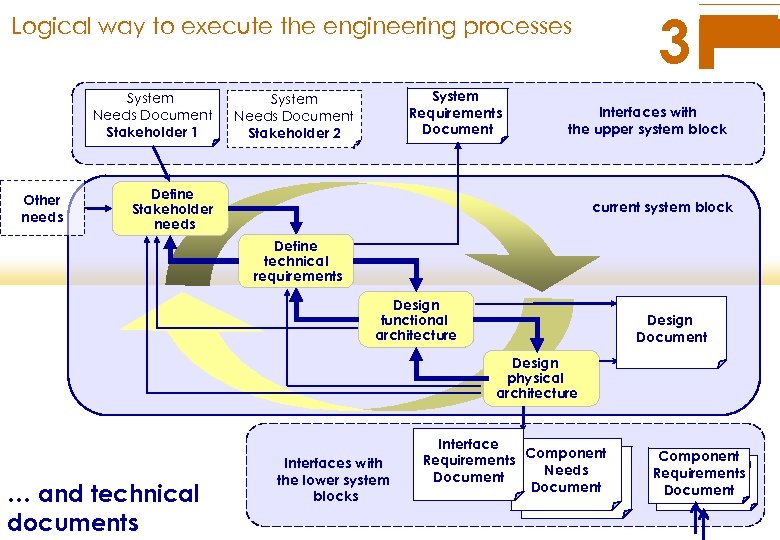 3 Logical way to execute the engineering processes System Needs Document Stakeholder 1 Other needs System Requirements Document System Needs Document Stakeholder 2 Interfaces with the upper system block Define Stakeholder needs current system block Define technical requirements Design functional architecture Design Document Design physical architecture … and technical documents Interfaces with the lower system blocks Interface Component Requirements Needs Document Component Spécification Requirements Technique Document constituant
3 Logical way to execute the engineering processes System Needs Document Stakeholder 1 Other needs System Requirements Document System Needs Document Stakeholder 2 Interfaces with the upper system block Define Stakeholder needs current system block Define technical requirements Design functional architecture Design Document Design physical architecture … and technical documents Interfaces with the lower system blocks Interface Component Requirements Needs Document Component Spécification Requirements Technique Document constituant
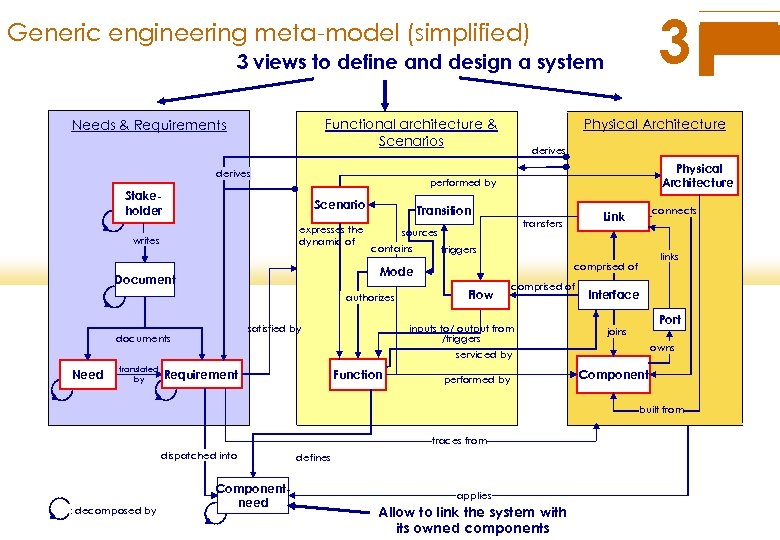 3 Generic engineering meta-model (simplified) 3 views to define and design a system Physical Architecture Functional architecture & Scenarios Needs & Requirements derives Physical Architecture performed by Stakeholder Scenario writes expresses the dynamic of Transition sources contains triggers authorizes documents Flow comprised of inputs to/ output from /triggers satisfied by links comprised of Mode Document connects Link transfers Interface Port joins owns serviced by Need translated by Requirement Function performed by Component built from traces from dispatched into : decomposed by Componentneed defines applies Allow to link the system with its owned components
3 Generic engineering meta-model (simplified) 3 views to define and design a system Physical Architecture Functional architecture & Scenarios Needs & Requirements derives Physical Architecture performed by Stakeholder Scenario writes expresses the dynamic of Transition sources contains triggers authorizes documents Flow comprised of inputs to/ output from /triggers satisfied by links comprised of Mode Document connects Link transfers Interface Port joins owns serviced by Need translated by Requirement Function performed by Component built from traces from dispatched into : decomposed by Componentneed defines applies Allow to link the system with its owned components
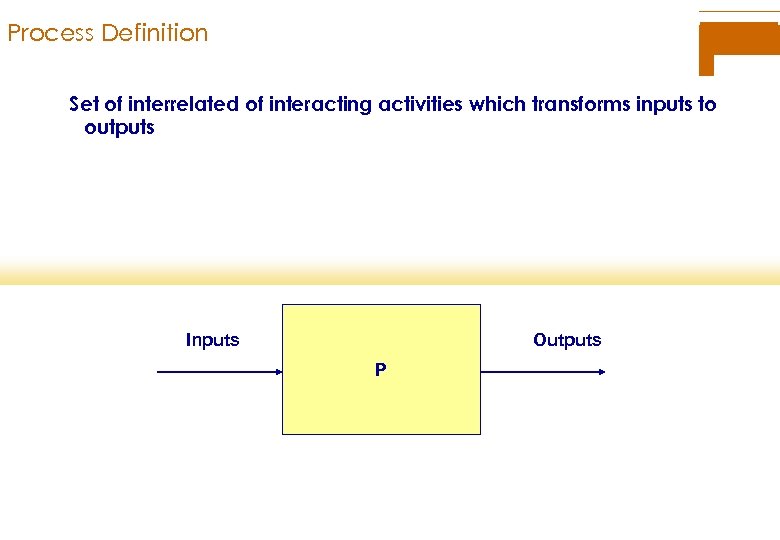 Process Definition Set of interrelated of interacting activities which transforms inputs to outputs Inputs Outputs P
Process Definition Set of interrelated of interacting activities which transforms inputs to outputs Inputs Outputs P
 A Process
A Process
 Process: V cycle
Process: V cycle
 Iterative and Incremental Iterative Incremental
Iterative and Incremental Iterative Incremental
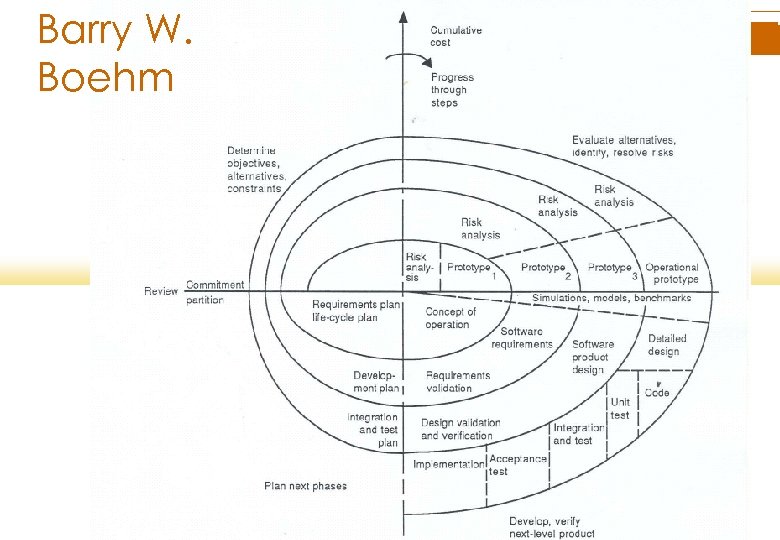 Barry W. Boehm
Barry W. Boehm
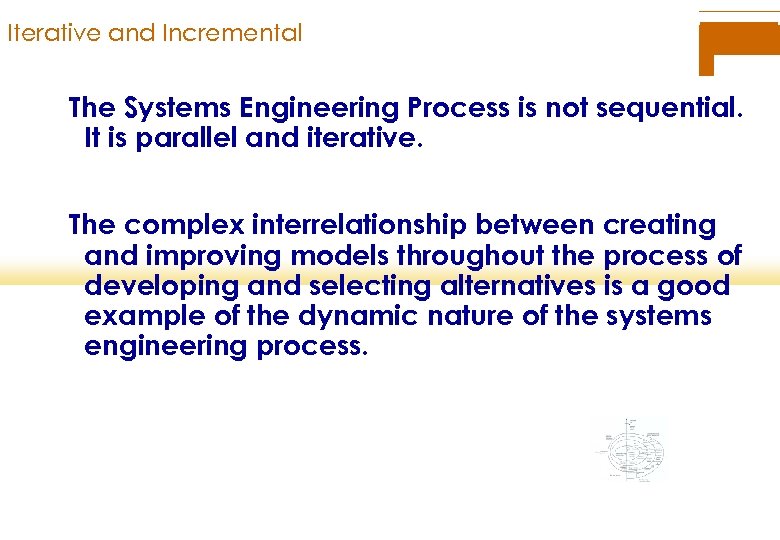 Iterative and Incremental The Systems Engineering Process is not sequential. It is parallel and iterative. The complex interrelationship between creating and improving models throughout the process of developing and selecting alternatives is a good example of the dynamic nature of the systems engineering process.
Iterative and Incremental The Systems Engineering Process is not sequential. It is parallel and iterative. The complex interrelationship between creating and improving models throughout the process of developing and selecting alternatives is a good example of the dynamic nature of the systems engineering process.
 Process Standardization NASA DOD (US Departement Of Defense): ¦Documentation Model IEEE ISO (International Organization for Standardization) IEC (International Electrotechnical Committee). ¦ISO/IEC 15504 / SPICE (Software Process Improvement and Capability d. Etermination) SEI (Software Engineering Institute)
Process Standardization NASA DOD (US Departement Of Defense): ¦Documentation Model IEEE ISO (International Organization for Standardization) IEC (International Electrotechnical Committee). ¦ISO/IEC 15504 / SPICE (Software Process Improvement and Capability d. Etermination) SEI (Software Engineering Institute)
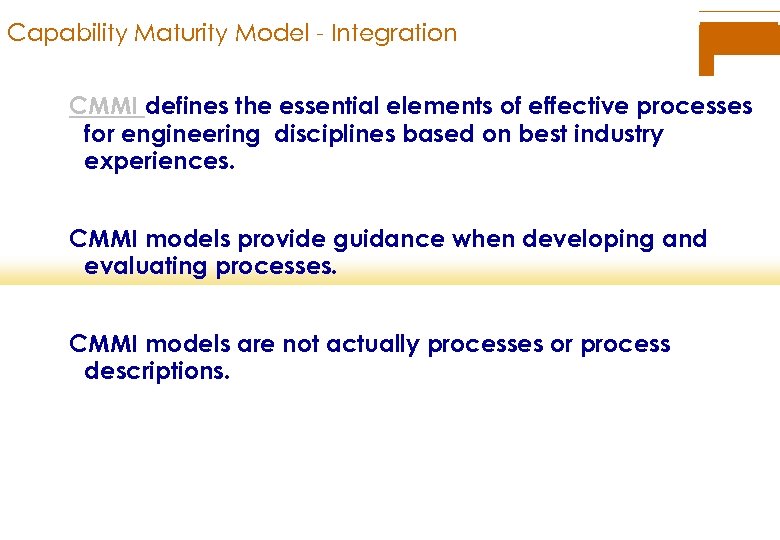 Capability Maturity Model - Integration CMMI defines the essential elements of effective processes for engineering disciplines based on best industry experiences. CMMI models provide guidance when developing and evaluating processes. CMMI models are not actually processes or process descriptions.
Capability Maturity Model - Integration CMMI defines the essential elements of effective processes for engineering disciplines based on best industry experiences. CMMI models provide guidance when developing and evaluating processes. CMMI models are not actually processes or process descriptions.
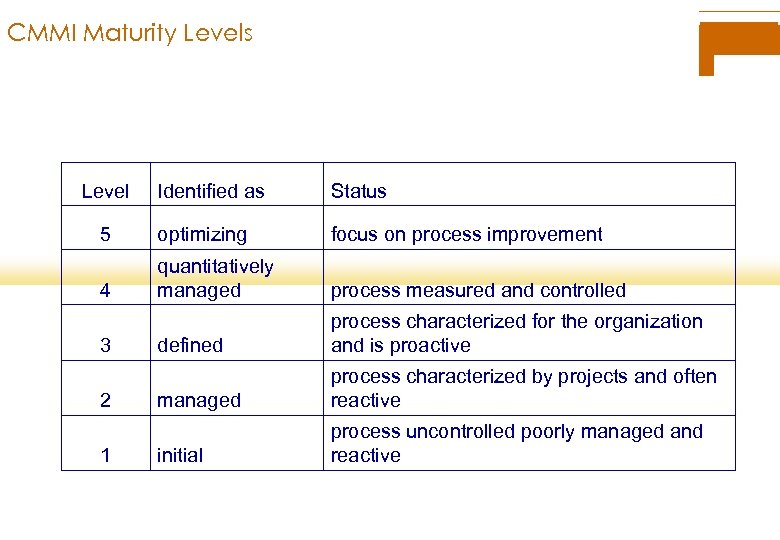 CMMI Maturity Levels Level Identified as Status 5 optimizing focus on process improvement 4 quantitatively managed process measured and controlled defined process characterized for the organization and is proactive managed process characterized by projects and often reactive initial process uncontrolled poorly managed and reactive 3 2 1
CMMI Maturity Levels Level Identified as Status 5 optimizing focus on process improvement 4 quantitatively managed process measured and controlled defined process characterized for the organization and is proactive managed process characterized by projects and often reactive initial process uncontrolled poorly managed and reactive 3 2 1
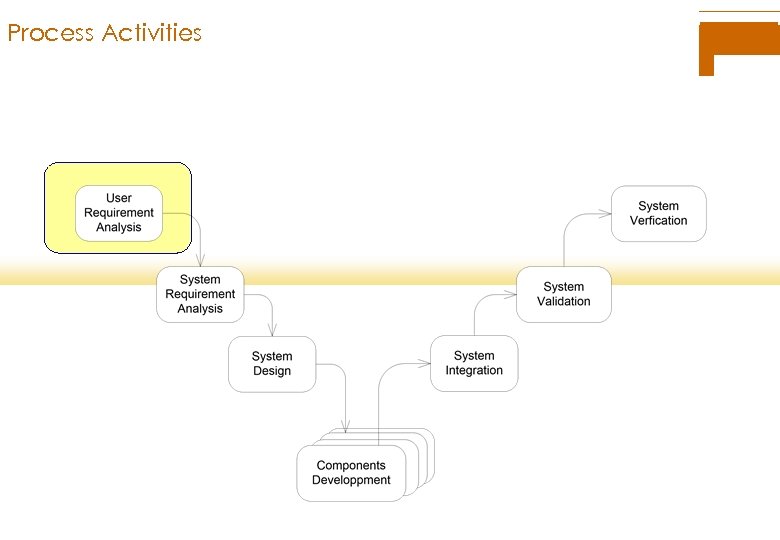 Process Activities
Process Activities
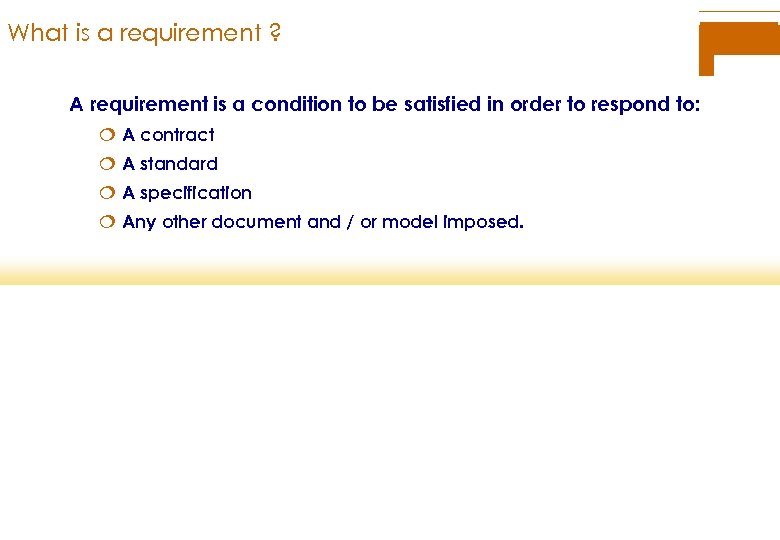 What is a requirement ? A requirement is a condition to be satisfied in order to respond to: ¦ A contract ¦ A standard ¦ A specification ¦ Any other document and / or model imposed.
What is a requirement ? A requirement is a condition to be satisfied in order to respond to: ¦ A contract ¦ A standard ¦ A specification ¦ Any other document and / or model imposed.
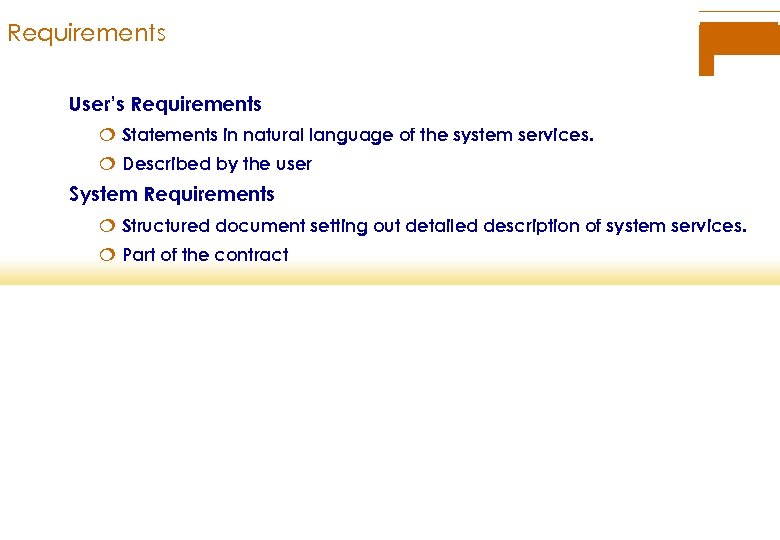 Requirements User’s Requirements ¦ Statements in natural language of the system services. ¦ Described by the user System Requirements ¦ Structured document setting out detailed description of system services. ¦ Part of the contract
Requirements User’s Requirements ¦ Statements in natural language of the system services. ¦ Described by the user System Requirements ¦ Structured document setting out detailed description of system services. ¦ Part of the contract
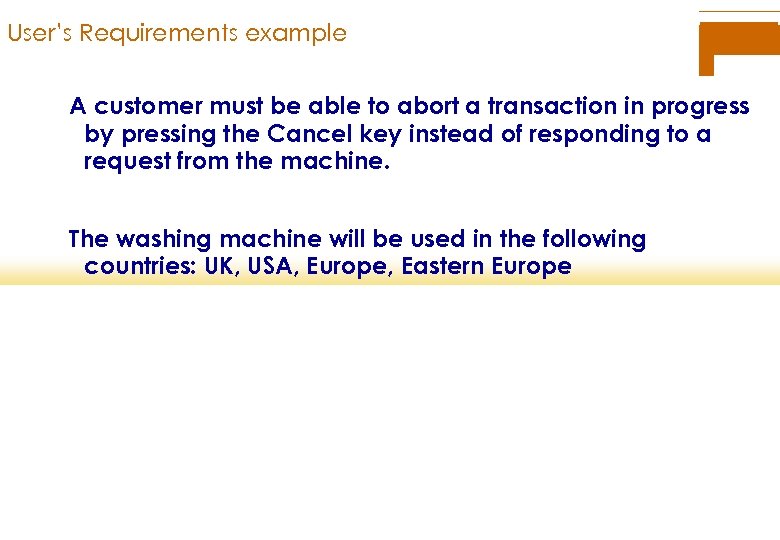 User’s Requirements example A customer must be able to abort a transaction in progress by pressing the Cancel key instead of responding to a request from the machine. The washing machine will be used in the following countries: UK, USA, Europe, Eastern Europe
User’s Requirements example A customer must be able to abort a transaction in progress by pressing the Cancel key instead of responding to a request from the machine. The washing machine will be used in the following countries: UK, USA, Europe, Eastern Europe
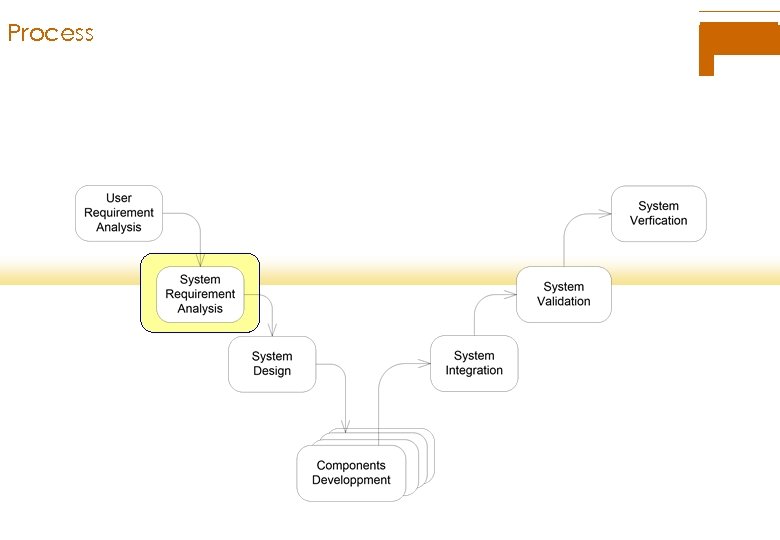 Process
Process
 System Requirements The System shall provide. . . . The System shall be capable of. . . . The System shall weigh. . . . The Subsystem #1 shall provide. . . . The Subsystem #2 shall interface with. . .
System Requirements The System shall provide. . . . The System shall be capable of. . . . The System shall weigh. . . . The Subsystem #1 shall provide. . . . The Subsystem #2 shall interface with. . .
 Requirement Quality A good requirement states something that is necessary, verifiable, and attainable To be verifiable, the requirement must state something that can be verified by: ¦ analysis, inspection, test, or demonstration (AIDT)
Requirement Quality A good requirement states something that is necessary, verifiable, and attainable To be verifiable, the requirement must state something that can be verified by: ¦ analysis, inspection, test, or demonstration (AIDT)
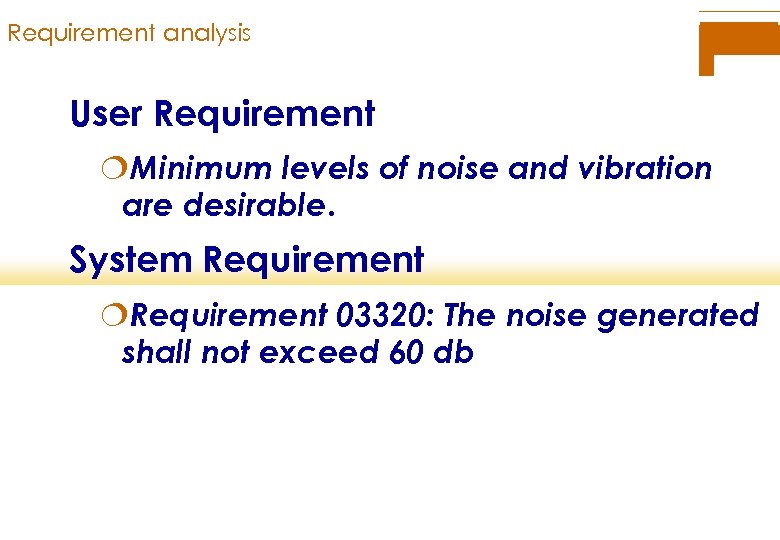 Requirement analysis User Requirement ¦Minimum levels of noise and vibration are desirable. System Requirement ¦Requirement 03320: The noise generated shall not exceed 60 db
Requirement analysis User Requirement ¦Minimum levels of noise and vibration are desirable. System Requirement ¦Requirement 03320: The noise generated shall not exceed 60 db
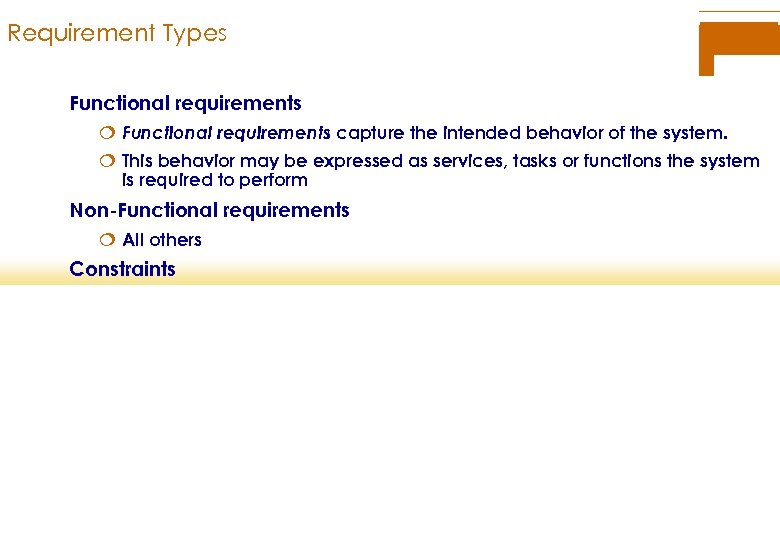 Requirement Types Functional requirements ¦ Functional requirements capture the intended behavior of the system. ¦ This behavior may be expressed as services, tasks or functions the system is required to perform Non-Functional requirements ¦ All others Constraints
Requirement Types Functional requirements ¦ Functional requirements capture the intended behavior of the system. ¦ This behavior may be expressed as services, tasks or functions the system is required to perform Non-Functional requirements ¦ All others Constraints
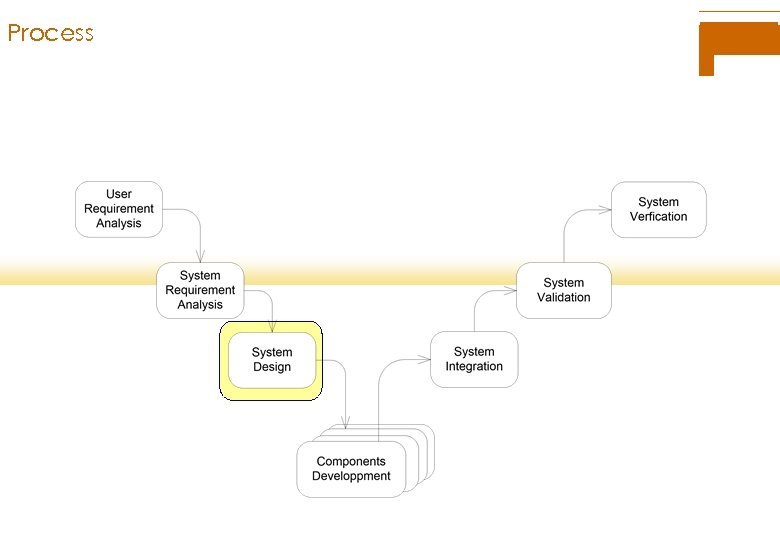 Process
Process
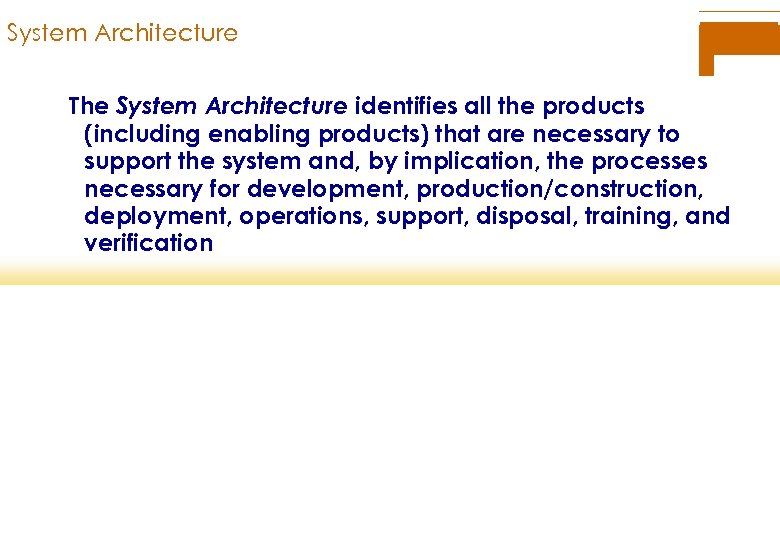 System Architecture The System Architecture identifies all the products (including enabling products) that are necessary to support the system and, by implication, the processes necessary for development, production/construction, deployment, operations, support, disposal, training, and verification
System Architecture The System Architecture identifies all the products (including enabling products) that are necessary to support the system and, by implication, the processes necessary for development, production/construction, deployment, operations, support, disposal, training, and verification
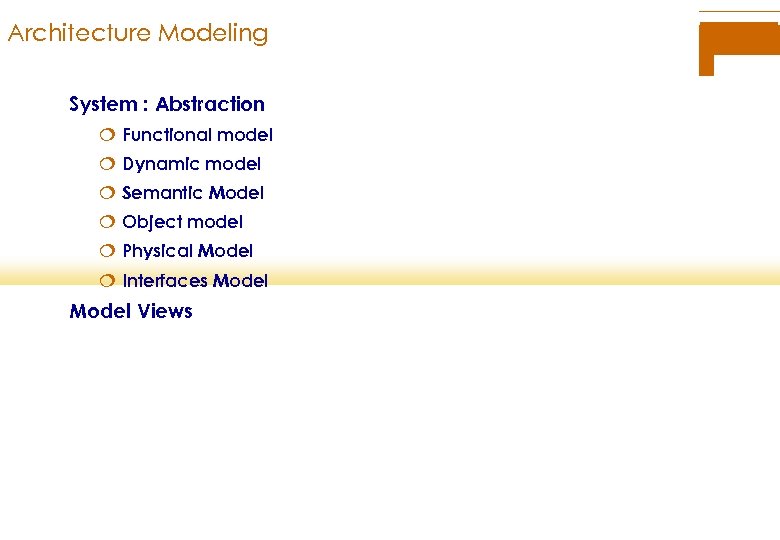 Architecture Modeling System : Abstraction ¦ Functional model ¦ Dynamic model ¦ Semantic Model ¦ Object model ¦ Physical Model ¦ Interfaces Model Views
Architecture Modeling System : Abstraction ¦ Functional model ¦ Dynamic model ¦ Semantic Model ¦ Object model ¦ Physical Model ¦ Interfaces Model Views
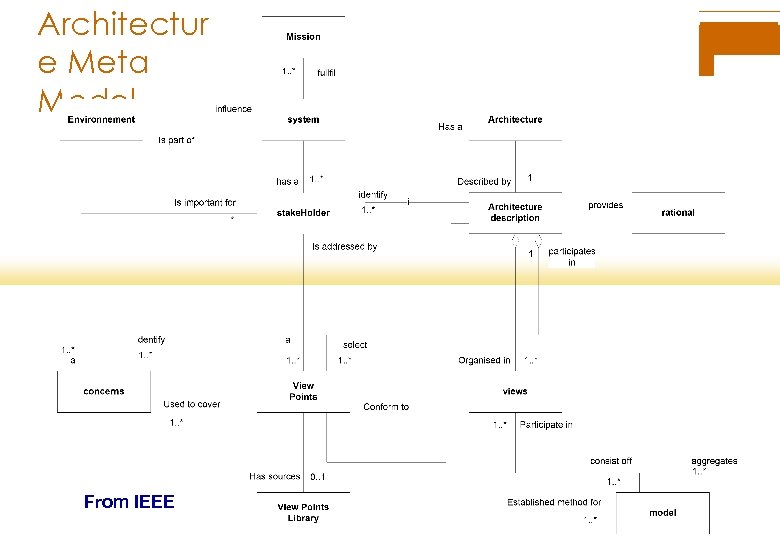 Architectur e Meta Model From IEEE
Architectur e Meta Model From IEEE
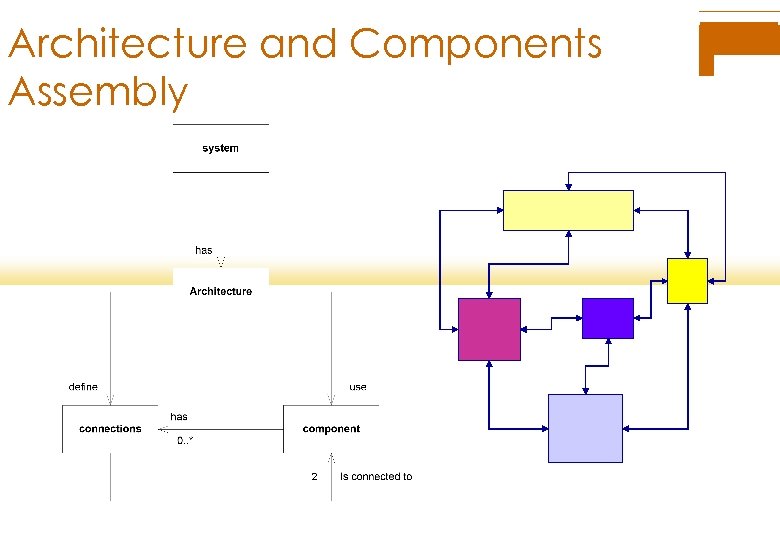 Architecture and Components Assembly
Architecture and Components Assembly
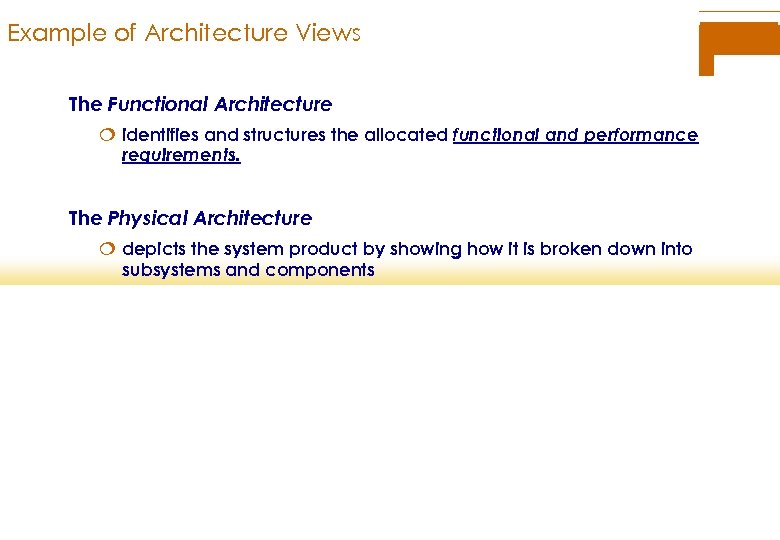 Example of Architecture Views The Functional Architecture ¦ identifies and structures the allocated functional and performance requirements. The Physical Architecture ¦ depicts the system product by showing how it is broken down into subsystems and components
Example of Architecture Views The Functional Architecture ¦ identifies and structures the allocated functional and performance requirements. The Physical Architecture ¦ depicts the system product by showing how it is broken down into subsystems and components
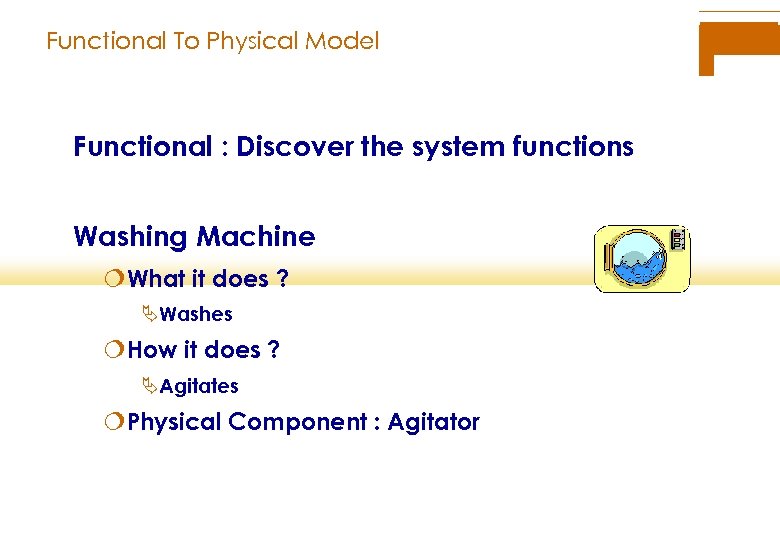 Functional To Physical Model Functional : Discover the system functions Washing Machine ¦What it does ? ÄWashes ¦How it does ? ÄAgitates ¦Physical Component : Agitator
Functional To Physical Model Functional : Discover the system functions Washing Machine ¦What it does ? ÄWashes ¦How it does ? ÄAgitates ¦Physical Component : Agitator
 Functional VS physical Model How to fly ? Look at birds: Physical Model So I need: Legs, Eyes, Brain, and Wings. But I can not fly !!! Why ? I have to find the flight functional model !
Functional VS physical Model How to fly ? Look at birds: Physical Model So I need: Legs, Eyes, Brain, and Wings. But I can not fly !!! Why ? I have to find the flight functional model !
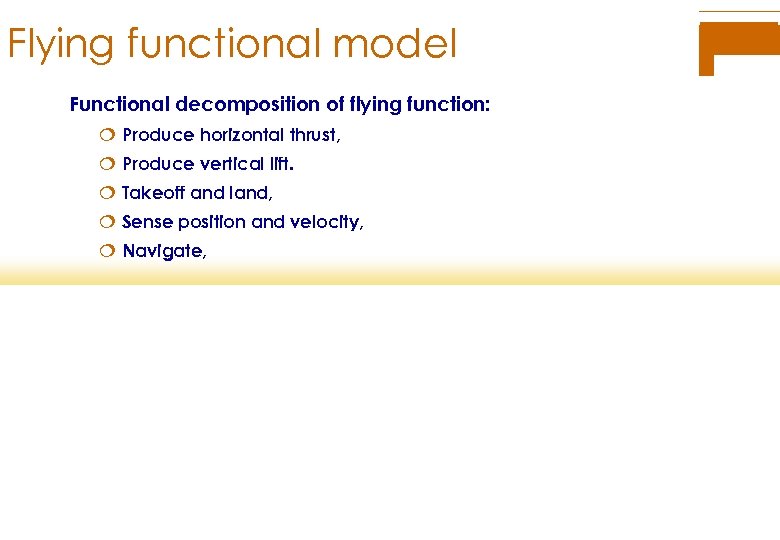 Flying functional model Functional decomposition of flying function: ¦ Produce horizontal thrust, ¦ Produce vertical lift. ¦ Takeoff and land, ¦ Sense position and velocity, ¦ Navigate,
Flying functional model Functional decomposition of flying function: ¦ Produce horizontal thrust, ¦ Produce vertical lift. ¦ Takeoff and land, ¦ Sense position and velocity, ¦ Navigate,
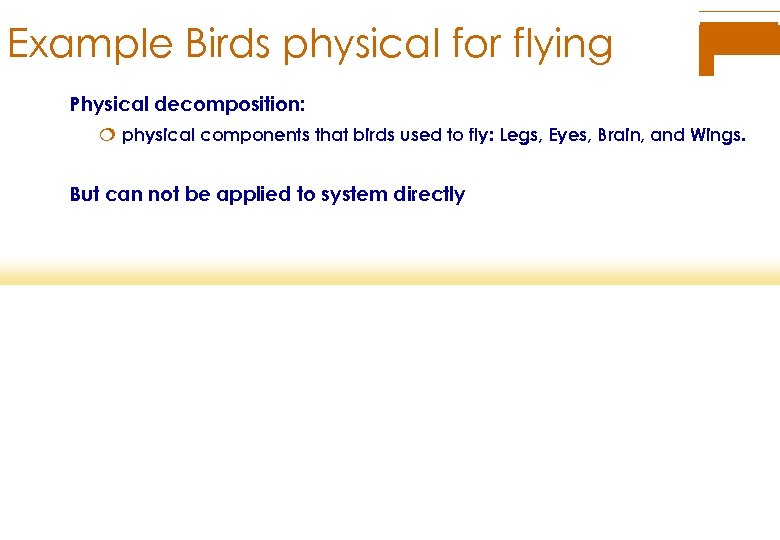 Example Birds physical for flying Physical decomposition: ¦ physical components that birds used to fly: Legs, Eyes, Brain, and Wings. But can not be applied to system directly
Example Birds physical for flying Physical decomposition: ¦ physical components that birds used to fly: Legs, Eyes, Brain, and Wings. But can not be applied to system directly
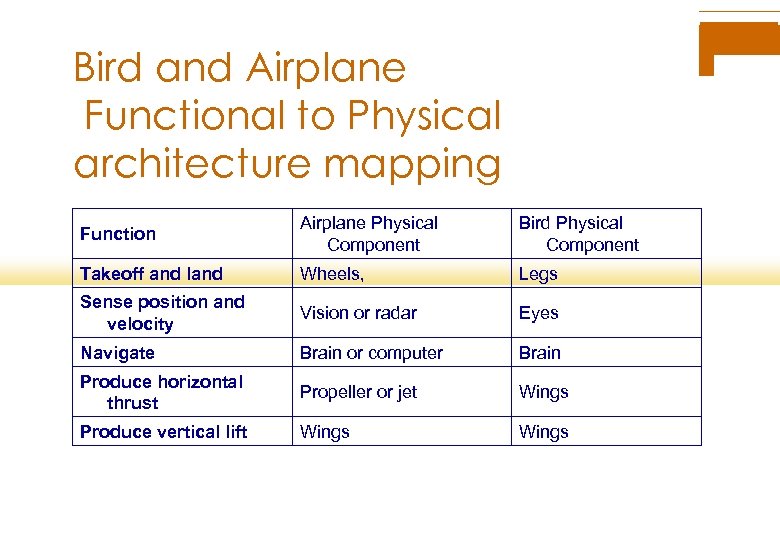 Bird and Airplane Functional to Physical architecture mapping Function Airplane Physical Component Bird Physical Component Takeoff and land Wheels, Legs Sense position and velocity Vision or radar Eyes Navigate Brain or computer Brain Produce horizontal thrust Propeller or jet Wings Produce vertical lift Wings
Bird and Airplane Functional to Physical architecture mapping Function Airplane Physical Component Bird Physical Component Takeoff and land Wheels, Legs Sense position and velocity Vision or radar Eyes Navigate Brain or computer Brain Produce horizontal thrust Propeller or jet Wings Produce vertical lift Wings
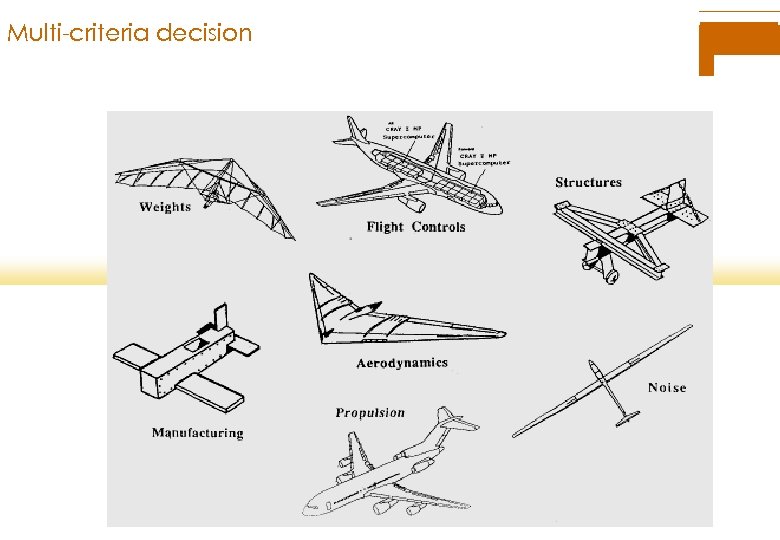 Multi-criteria decision
Multi-criteria decision
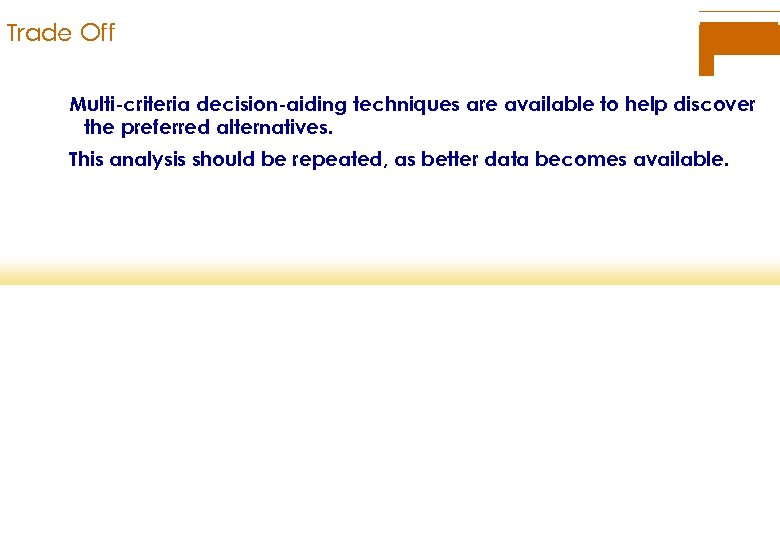 Trade Off Multi-criteria decision-aiding techniques are available to help discover the preferred alternatives. This analysis should be repeated, as better data becomes available.
Trade Off Multi-criteria decision-aiding techniques are available to help discover the preferred alternatives. This analysis should be repeated, as better data becomes available.
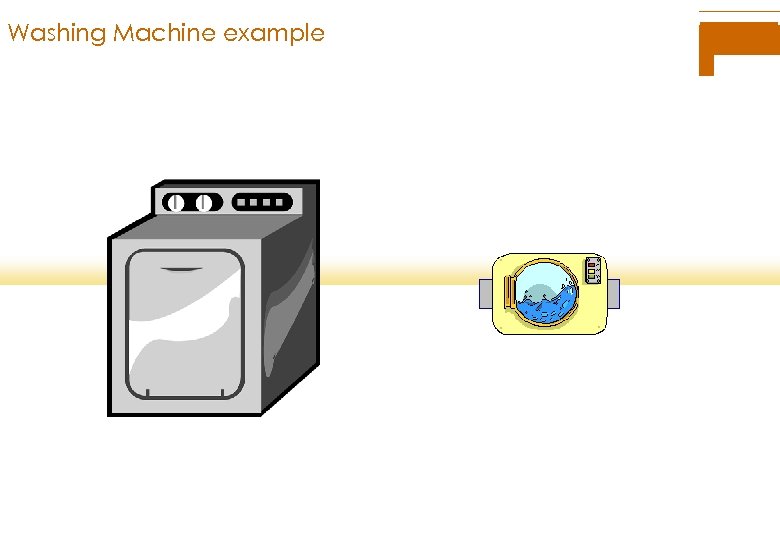 Washing Machine example
Washing Machine example
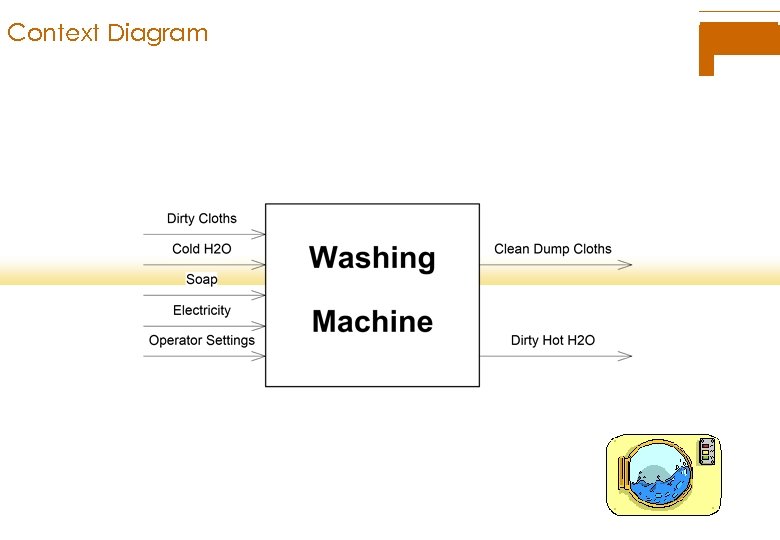 Context Diagram
Context Diagram
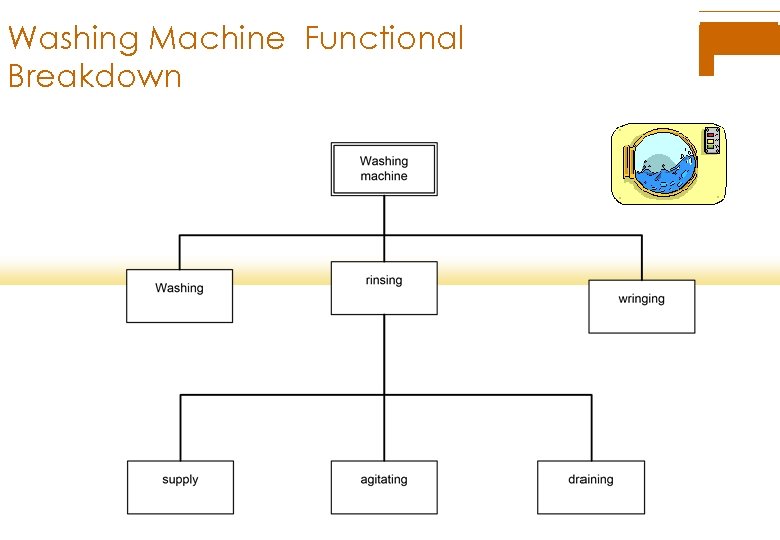 Washing Machine Functional Breakdown
Washing Machine Functional Breakdown
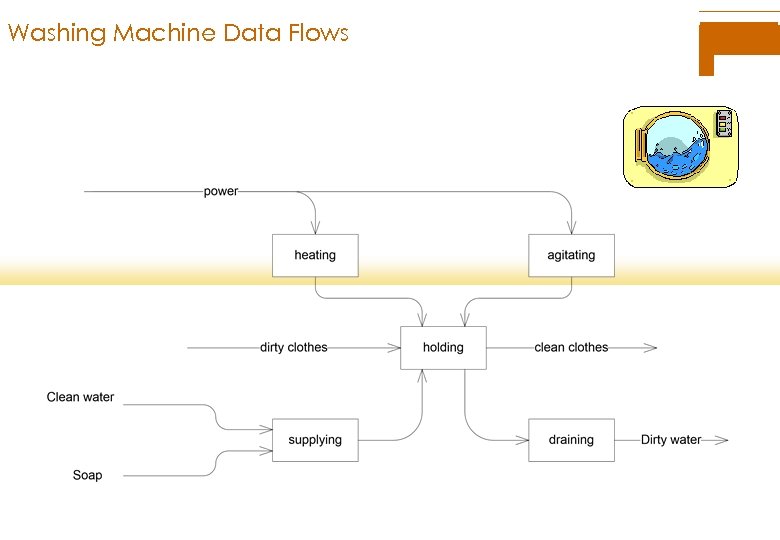 Washing Machine Data Flows
Washing Machine Data Flows
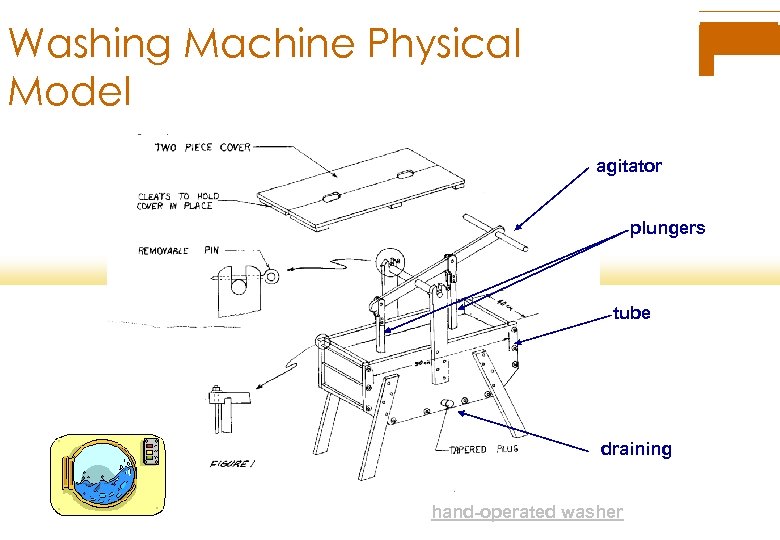 Washing Machine Physical Model agitator plungers tube draining hand-operated washer
Washing Machine Physical Model agitator plungers tube draining hand-operated washer
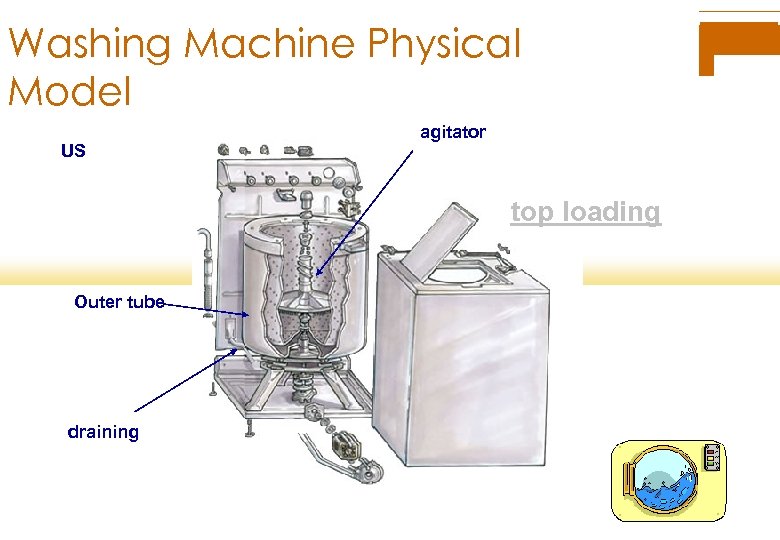 Washing Machine Physical Model US agitator top loading Outer tube draining
Washing Machine Physical Model US agitator top loading Outer tube draining
 Washing Machine Physical Model top loading
Washing Machine Physical Model top loading
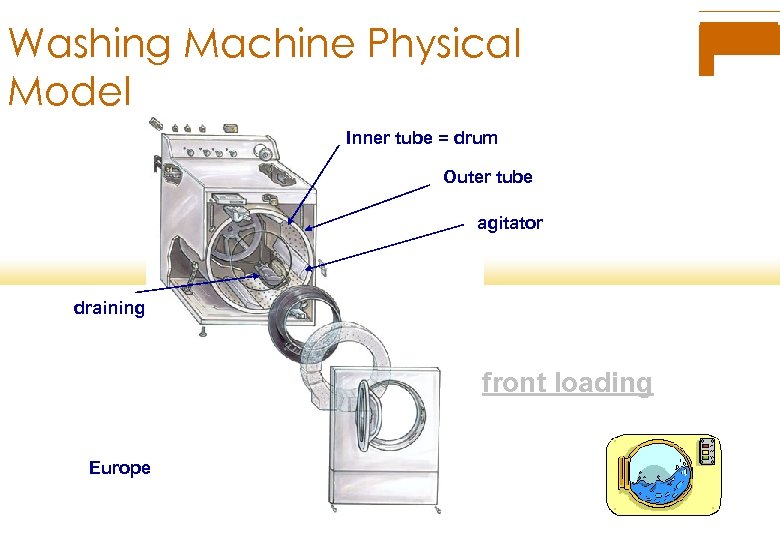 Washing Machine Physical Model Inner tube = drum Outer tube agitator draining front loading Europe
Washing Machine Physical Model Inner tube = drum Outer tube agitator draining front loading Europe
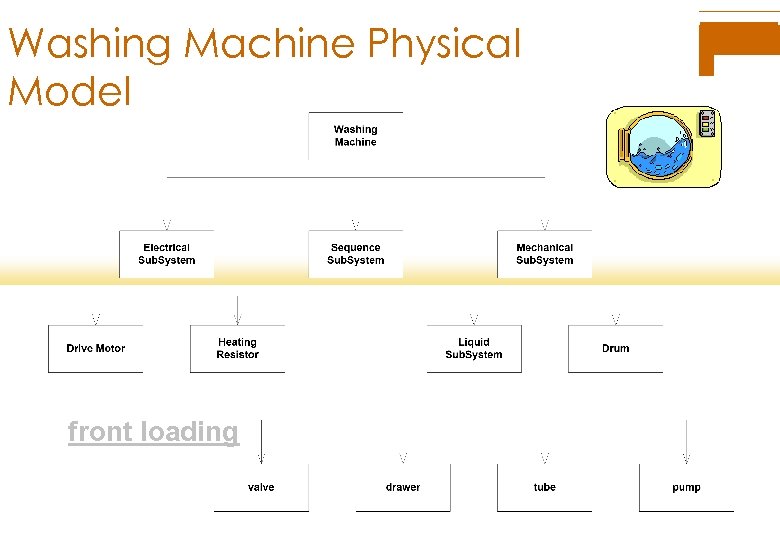 Washing Machine Physical Model front loading
Washing Machine Physical Model front loading
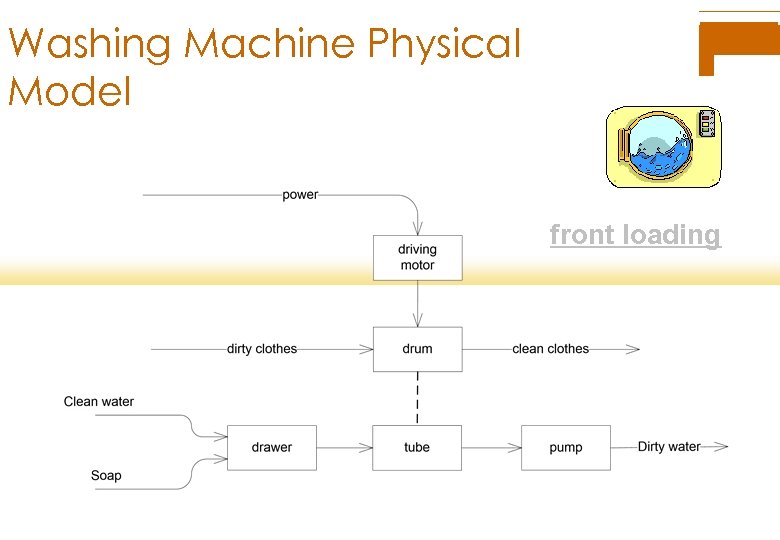 Washing Machine Physical Model front loading
Washing Machine Physical Model front loading
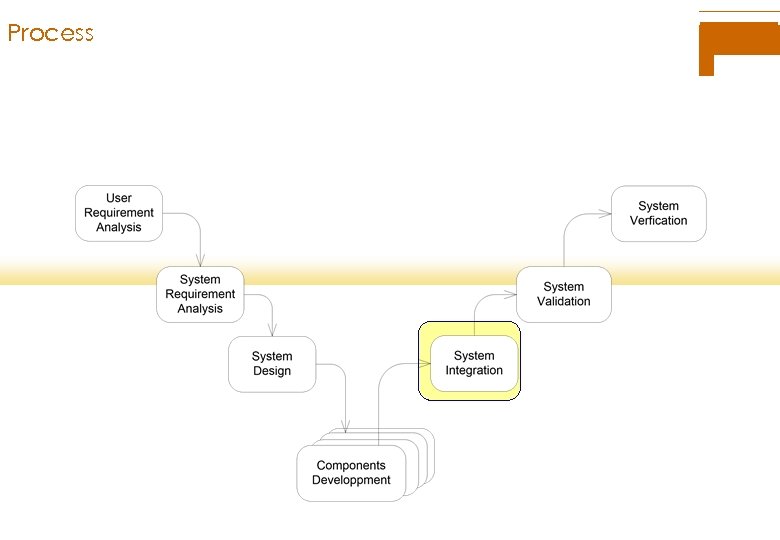 Process
Process
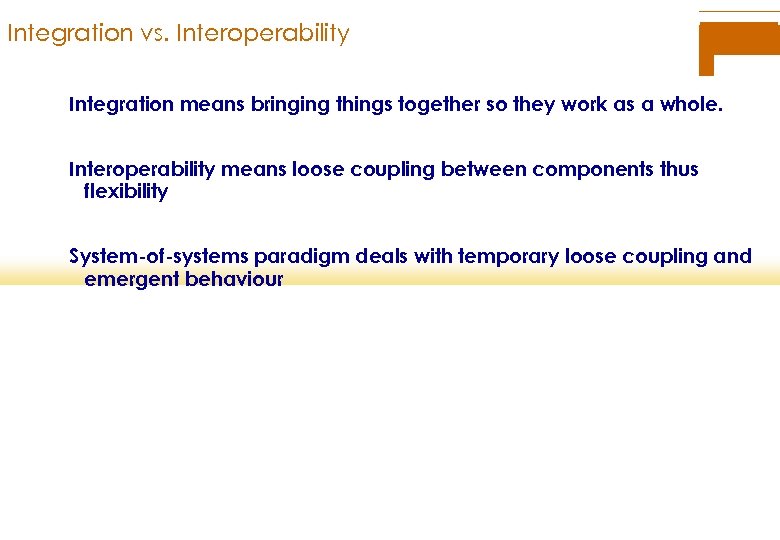 Integration vs. Interoperability Integration means bringing things together so they work as a whole. Interoperability means loose coupling between components thus flexibility System-of-systems paradigm deals with temporary loose coupling and emergent behaviour
Integration vs. Interoperability Integration means bringing things together so they work as a whole. Interoperability means loose coupling between components thus flexibility System-of-systems paradigm deals with temporary loose coupling and emergent behaviour
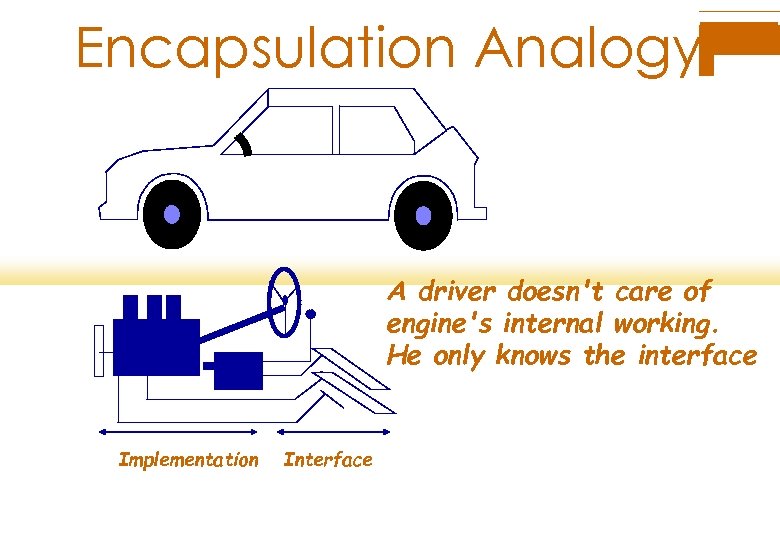 Encapsulation Analogy A driver doesn't care of engine's internal working. He only knows the interface Implementation Interface
Encapsulation Analogy A driver doesn't care of engine's internal working. He only knows the interface Implementation Interface
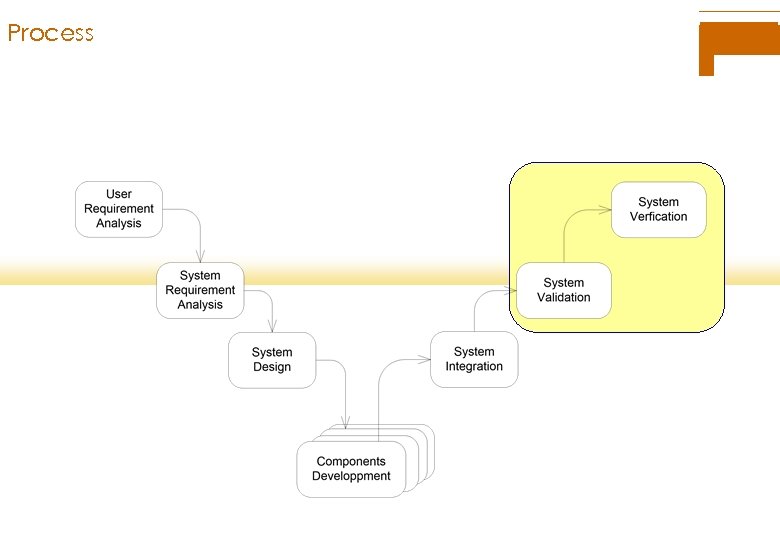 Process
Process
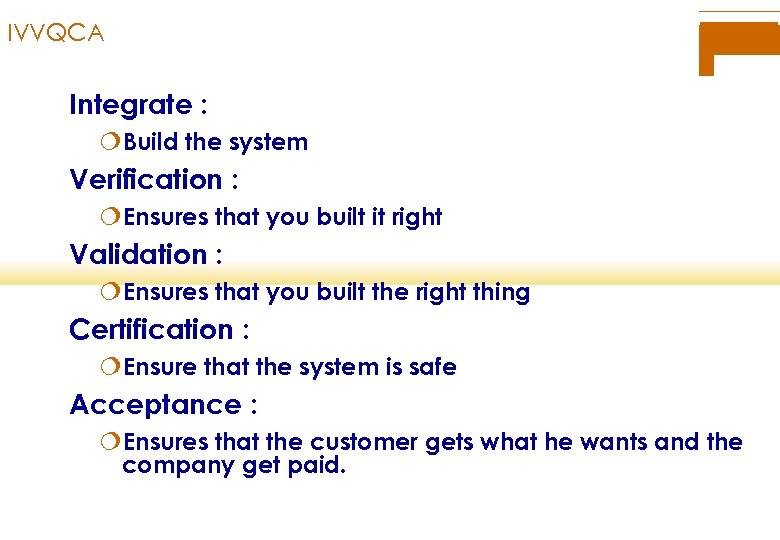 IVVQCA Integrate : ¦Build the system Verification : ¦Ensures that you built it right Validation : ¦Ensures that you built the right thing Certification : ¦Ensure that the system is safe Acceptance : ¦Ensures that the customer gets what he wants and the company get paid.
IVVQCA Integrate : ¦Build the system Verification : ¦Ensures that you built it right Validation : ¦Ensures that you built the right thing Certification : ¦Ensure that the system is safe Acceptance : ¦Ensures that the customer gets what he wants and the company get paid.
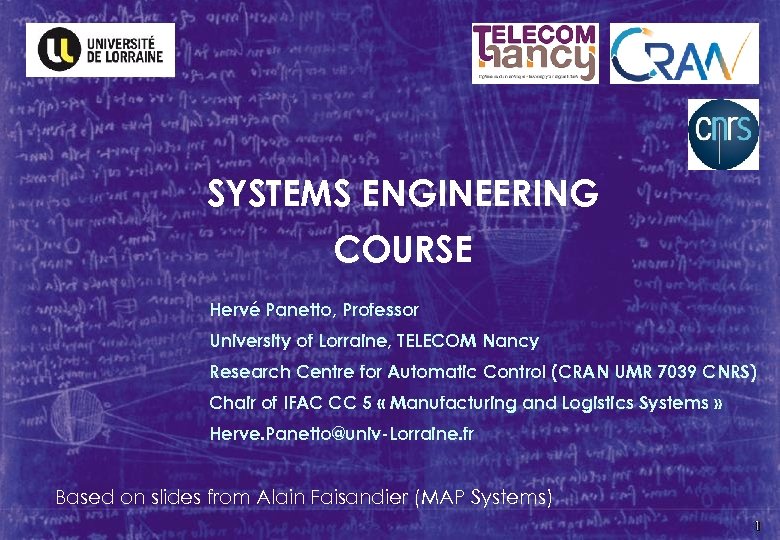 SYSTEMS ENGINEERING COURSE Hervé Panetto, Professor University of Lorraine, TELECOM Nancy Research Centre for Automatic Control (CRAN UMR 7039 CNRS) Chair of IFAC CC 5 « Manufacturing and Logistics Systems » Herve. Panetto@univ-Lorraine. fr Based on slides from Alain Faisandier (MAP Systems)
SYSTEMS ENGINEERING COURSE Hervé Panetto, Professor University of Lorraine, TELECOM Nancy Research Centre for Automatic Control (CRAN UMR 7039 CNRS) Chair of IFAC CC 5 « Manufacturing and Logistics Systems » Herve. Panetto@univ-Lorraine. fr Based on slides from Alain Faisandier (MAP Systems)


